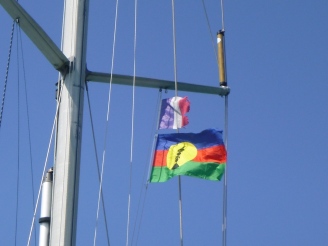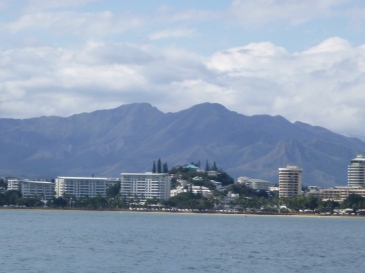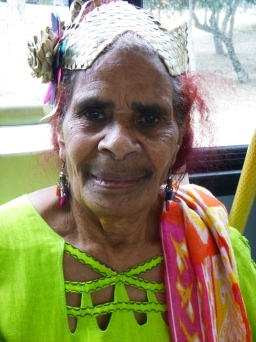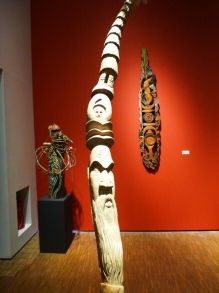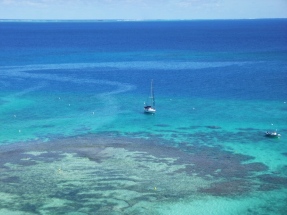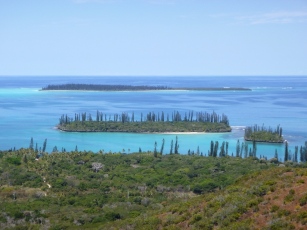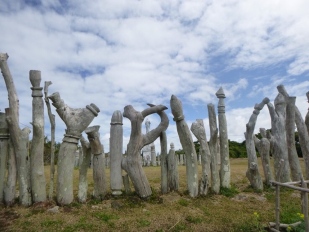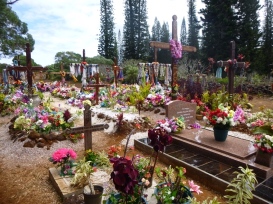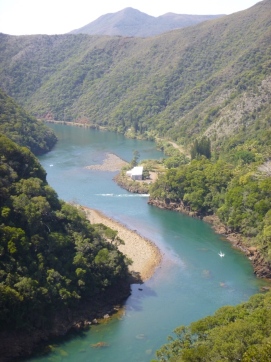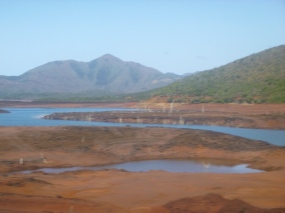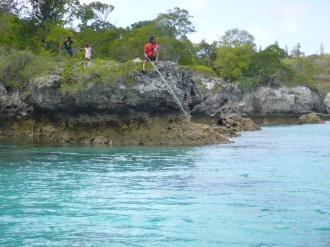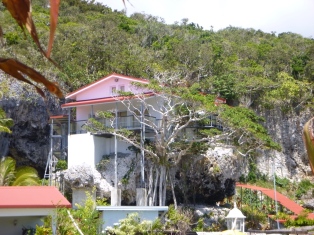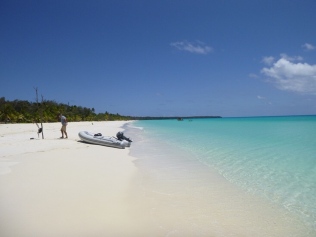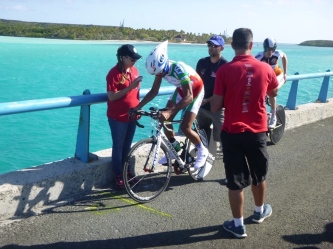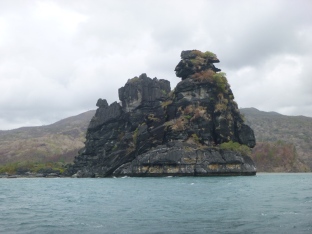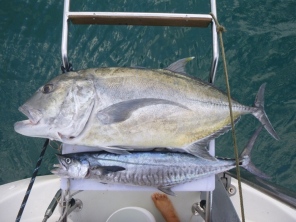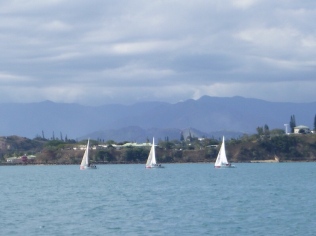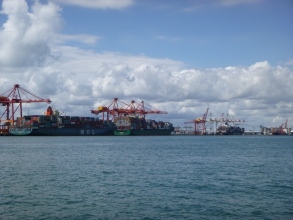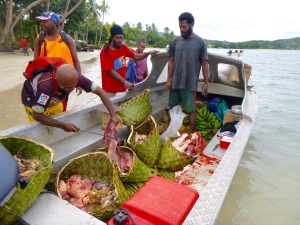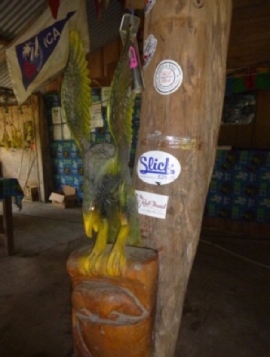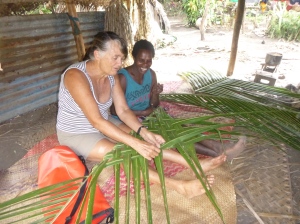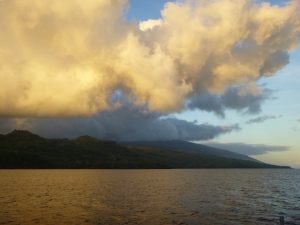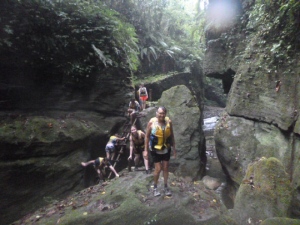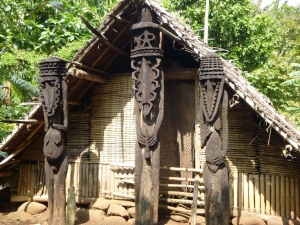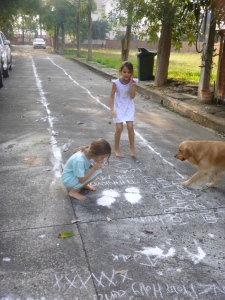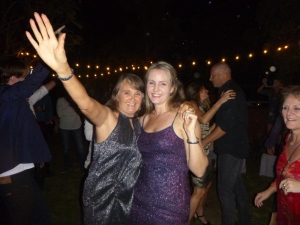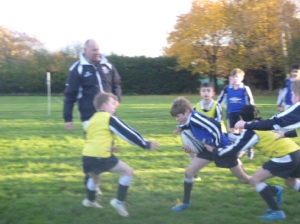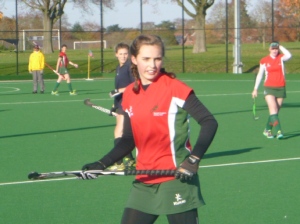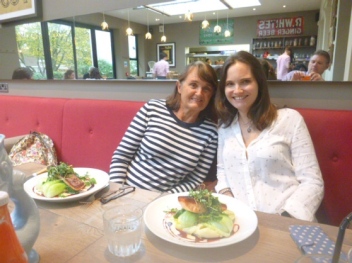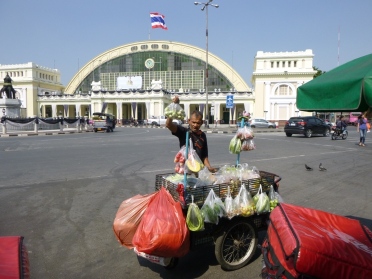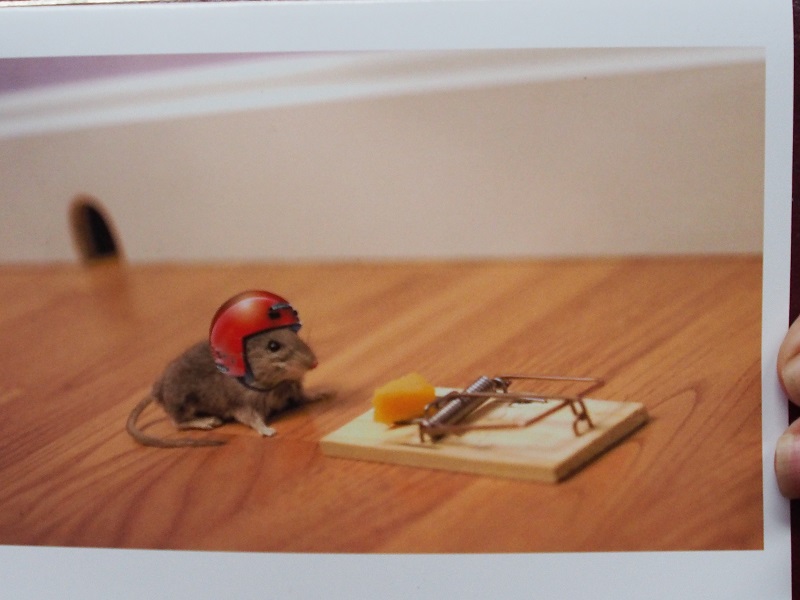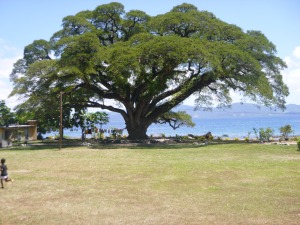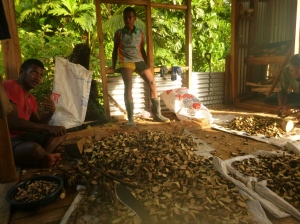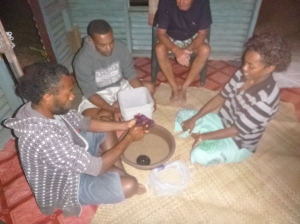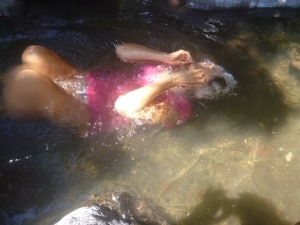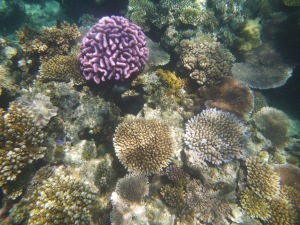Leaving Vanua Levu (SavuSavu) after only a week was like saying goodbye to an old friend, we already felt part of the scenery. We bought our kava for the villages we intended to visit, stocked up our provisions, renewed our gas supplies and headed towards the Yasawa Islands.
The Yasawa islands stretch in a chain from north to south along the Western edge of the main island of Fiji, Viti Levu, and we intended to follow the islands south towards the Mamachuk islands and eventually check out at our final port of call, Vuda Point on Viti Levu.
Into a Leper Colony
When we entered the small bay at the island of Mokogai we were expecting to see remnants of the ex-leper colony as well as a modern village. There was very little activity in evidence except for some construction on the foreshore. Armed with our predictable newspaper-wrapped packet of kava and our sulus (long skirts or wraps) we kayaked to the beach. It soon became obvious that we were witnessing a work in progress, two new round concrete pools were being tested for their imminent use as clam and turtle hatcheries – another eco project in the offing.
After a very perfunctory sevusevu (kava ceremony) with gabbled murmurings over the kitchen table by the boss of the construction work, we were led along paths to witness and hear about the historical leper colony which finally closed in 1969 after a cure had been found. The remains of the village showed it to have been an extensive and comprehensive stone-built settlement (housing, schools, cemetery, prison, even an open-aired cinema) which had held 400 inhabitants from many countries of the South Pacific.

We were urged to swim and see a number of giant clams which had survived the last cyclone and had been returned to the seabed, the beginning, they hoped, of a new colony. The clams were, indeed, amazing and as Mike said, reminded him of “daring-do” and “Boys’ Own” stories in his childhood – no trapped arms or legs today though!
At our next anchorage north of the main island of Viti Levu we witnessed a little more of the ferocity of the storm and damage caused by Cyclone Winston earlier this year. We could hardly miss the upturned catamaran hull just off the beach and the pretty little yacht perched drunkenly on a pile of rocks on the tiny offshore resort. We even found an abandoned kayak in perfect condition on the beach but we couldn’t think how we could realistically get it to our friends in Naqaravutu Village – such a waste.

Sailing out of this anchorage after dark following our entry track was an eery feeling knowing there was treacherous reef on either side but seeing nothing. Again we needed a slowish night passage to arrive in good light in the morning. So much of our sailing is a leap of faith, trusting to the electronic charts and during the day to eyeball navigatio and as has often been proved, the eyes can be more reliable than the charts!
The beautiful Yasawas
As planned, we arrived at our next destination Sawa i Lau on the northern most island of the Yasawas early in the morning and entered another beautiful, islet-sprinkled lagoon enclosed by towering cliffs and edged by sparkling sandy beaches.

Following the normal protocol, we wasted no time in kayaking to the nearby village with our offering of kava for the local chief. We had forgotten that it was Sunday, one day seems very like another to us, and it was only after the chief hurriedly dealt with us and our questions and sped through the necessary ceremony that we heard the singing from the nearby church and realised that he must have been summoned from his devotions to deal with us.
We slipped into the side entrance to witness the service and as usual immediately became objects of interest, especially to the children. In our scruffy t-shirts and shorts we felt very underdressed compared to the congregation, ladies in pretty flowered dresses, the children immaculate in their Sunday best and some of the men even sporting jackets, collars and ties to complement their sulus. This was a Methodist church and all seemed very much more serious than my last experience at the tiny wooden, rush-floored church in Naqaravutu. The children wandered around the aisles, paying little attention to the service and made their escape through the rear door when possible, surrounding us to practise their English when we emerged.
We had heard that the snorkelling here was good and after exploring the pretty anchorage with its weathered and rugged claim-encrusted rocks and picturesque sandy bays by kayak as the tide went down and left us high and dry, we set off along the reef. As usual our swim followed the drop off of the shore reef where the fish are most prolific. We were concerned to find several very large Crowns of Thorns – a variety of poisonous sea stars (reef predators) – which can in a very short time decimate huge areas of coral. Unfortunately, there was nothing we could do about this creature – in Vava’u in Tonga, protectors of the reef were asking for reports on their presence in an effort to control the pests, but in Fiji we didn’t know of such an organisation.
We continued our sail south, visiting a number of anchorages and more idyllic islands en route. With our kava in hand, we stopped off once more to pay our respects to the chief of yet another pretty island. The chief was, we were informed by his wife, Mila, who was lounging in the mid-day sun along with her women friends on a platform under the village meeting tree, away on the mainland at the moment. She accepted the kava from us and told us to return later when they had had their rest.

Mila expressed interest in my sunglasses and requested a pair! I had no spare sunglasses to offer but I promised that maybe I might find a pair of reading glasses for her. Having read somewhere that specs might be an acceptable and worthwhile present in the Pacific, I had armed myself with a bagful of varying strengths from Poundland, most of which I had given away in SavuSavu. When we returned the following day with one of my remaining pairs of plastic floral-rimmed lenses Mila was overjoyed and exclaimed with delight as she pulled out a tattered magazine, “it’s really clear now” – one happy customer and I shall always be sure of a welcome on that island!

A visit to the Blue Lagoon
We had agreed to meet up with Jessie and Neil and their visiting American friends in the justly famous and beautiful setting of the Blue Lagoon film, now more commercial than all those years ago with a new resort or two but nonetheless still picturesque. We climbed to the top of the island, meeting aboard his mechanical digger, the owner and entrepreneur of the two year old resort, a hard working, “rough and ready” Aussie ex-trucker, who had worked tirelessly to get the place up and running and was still very much hands on (up at 4am and bed at mid-night!). We admired his enterprise and hard work, but what an undertaking where everything has to be brought in from the “mainland”. And to think that Mike was indignant that they asked 50c per litre for tap water when he enquired to buy some!

Jessie and Neil had arranged to dine at a nearby island and attend a sevusevu ceremony there and we couldn’t miss out on this experience. The fine dining was a “feast” laid on for a dozen of us by a village lady in her home. With the help of mud crabs and fish caught by Neil that morning, seated on the rush-covered floor, we tucked into a selection of local delicacies. They certainly eat simply but well here.

The kava ceremony on the raised outside area of another house was, we ladies were told, for men only. The men seated themselves in the usual circle whilst we ladies “reluctantly” seated ourselves in the stalls and talked to the few “rebel” men who accepted their bowls of kava and then turned to conversation with us (much more interesting!). In addition a couple of young girls sought our company and giggling shared their boyfriend problems – women of every age, everywhere talk about the same things!
We continued our sail south. We had heard of a submerged plane just offshore and this sounded like an opportunity for a more unusual snorkel. But, first we would have to cross the intervening strip of jungle from our anchorage to the other coast, only a short walk we were told (another of those myths) and on a ready made path. We should know by now, that hearsay should be taken with a hefty pinch of salt!
Firstly, the path, when we eventually found what seemed like an indefinite track, came and went as we fought our way through the coconut-strewn undergrowth, under, over and through trailing vines, fallen trees, grabbing thorns and fighting off sticky spiders’ webs until, inevitably, I stumbled along one half hidden path and Mike losing sight of me, launched himself down another semi-track. Waiting on the far side, overlooking an endless stretch of sandy beach and five or six offshore islands with no obvious signs of anything looking like a plane, it became apparent that we were looking for a needle in a haystack. When Mike eventually emerged from the jungle with his report that the plane was somewhere between us and one of the tiny islands, but which one was anyone’s guess, we decided to call it a day and retrace our steps (well almost but with a few more side tracks) back the way we had come – mission not accomplished!
Making our way further south and in the knowledge that there was a “low” on its way and expecting winds anywhere from the north through to the south-east we vacated what we considered to be an unprotected anchorage and made our way round the corner, skirting some hazardous reefs into the expected protection of a westerly-facing bay. But, weather hardly ever seems to do what it’s predictions foretell.
Caught on a Leeshore
We had sympathetically watched some drenched tourists being transported by motorboats with their luggage and umbrellas battling the driving rain to the waiting ferry (what a way to end your holiday) believing ourselves to be wet but safe. How wrong can you be!? Without warning the wind did a sudden shift and suddenly we were experiencing the full force of it, driving us onshore with such a ferocity that within minutes the sea suddenly increased with roaring waves and wind-driven spume causing a white-out as we tossed and strained at anchor. We let out all but the last few metres of chain, powered up the engine and prayed that we would hold. With a horrible crunching and grinding as the bow jerked and juddered at the end of its tether it became obvious that we had attached ourselves to, or around, a bommie. We never thought we would be grateful for the presence of a submerged rock, but this time, it saved us from being deposited on a leeshore.
For several hours whilst the storm raged, we listened to the straining chain, wondering if it would hold, would the bommie keep us safe or would we have to ditch the anchor and head out through the reefs to open water – not a welcome prospect.
With relief we recognised that the wind was gradually shifting back behind the protecting headland to the south and we could breath again. By midnight all was calm once more and we slept in peace, wondering what we would find in the light of day.
Mike kayaked to the beach to rescue a bucket and an empty fuel can which had blown ashore (being red it wasn’t difficult to track). Then it was time to inspect the damage and see what surprises the bommies had in store for us. With Mike in the water directing operations and me on the helm we wove this way and that untangling the chain until we were once more free of the submerged rocks (turned out to be two of them involved!) and we hurriedly took in the chain and moved to open sea once more.
Under the force of the straining chain the bow roller and stainless steel anchor channel had splayed open – that was going to need a yard to re-fashion it. Apart from that and some chain scrapes along the bow we escaped unscathed, we were so lucky once again.
Still counting our blessings and on a clear, sunny day we motored out of the fateful bay and headed down the coast. It just goes to show that one’s concentration at sea cannot slip for a moment. Too close to the shore reef and having relaxed, the sudden rasping from the hull alerted us to the fact that we had, once again, ventured too close to shore – we had made contact with the reef and looking over the side were all too well aware of the coral ledge just beneath us. The rudder had jammed upon impact and as we hastily reversed off back into deep water, we experienced that “sinking” feeling once again – now what?! Mike went over the side and returned with a relieved grin, “I’ve given it (the rudder) a kick and it’s free again”! It appeared that we had been lucky yet again, only a few minor scratches on the keel and there appeared to be no damage to the rudder. How many lives do we have on this boat? We’ve surely used up more than nine!
The unsettled weather hadn’t finished with us yet and that night after more heavy rain and wind we were glad to make an unscheduled stop in near dark at the base of some surrounding high cliffs and at the mouth of a river (lots of lovely good-holding mud). Most of the time sailing is wonderful, but there are times when enough is enough and there comes a moment when you would like to be anywhere but on that boat – not often, I admit, but it happens!
Sad Farewells
We had agreed to catch up once again with Jessie and Neil to say our relectant farewells as they continued onwards to Vanuatu and Australia and we headed south to New Zealand. A couple of days in the busy tourist resort of Musket Cove was enough, tears were shed and hugs were exchanged before we headed for Vuda Point on Viti Levu to check out, leaving Jessie and Neil about to depart for their new life in Australia. We heard just before they left that Jessie had been offered a position in her field of Clinical Psychology at the University of Melbourne. We were so delighted for her, she and Neil were so desperate to start a new life in Australia and it seems that the door is now open to them – well done!
Our long journey of three years was coming to an end and we were preparing to say goodbye to Fabulous Fiji, hopefully to return another day. We entered the tiny circular marina at Vuda Point and were directed into our narrow spot, bow to the wall. We had been warned that getting on and off the boat, especially at low tide was going to be challenging. A small wooden platform juts out from the surrounding quay to one side of the bow and it’s a giant step up for anyone at low water, let alone a couple of OAPs. Once again our little folding ladder came into its own and resting over a fender suspended from the pulpit we had no difficulty in reaching the platform at any angle.
Vuda Marina on the west coast of Viti Levu is one of the few places to check out of Fiji and a favourite for all those heading west or south. Our couple of days there gave us a chance to assess the weather for our passage to New Zealand as well as provision for the ten day trip. This passage had long been at the back of our minds with plenty of stories of dreadful weather and rough seas and we wanted to make sure, or as sure as we could be, that we weren’t going to run into one of the Tasman Sea specials. There were others waiting to leave and we agreed that the coming Thursday, 21st October, was the Day to go, so fuelled up, water tanks full, fresh food for the passage, immigration formalities completed and we were on our way to the Land of the Long White Cloud.

